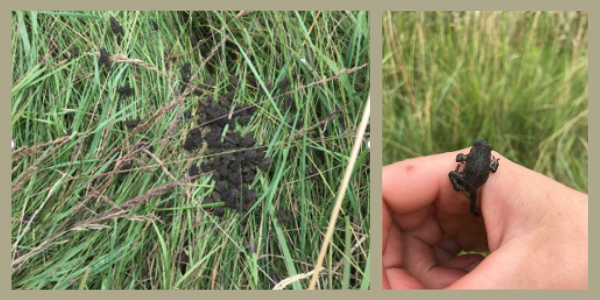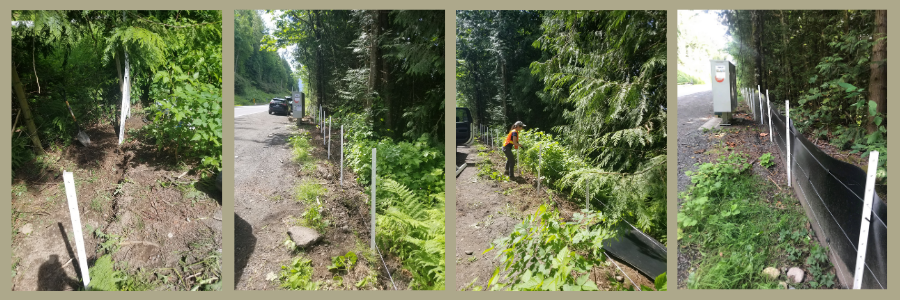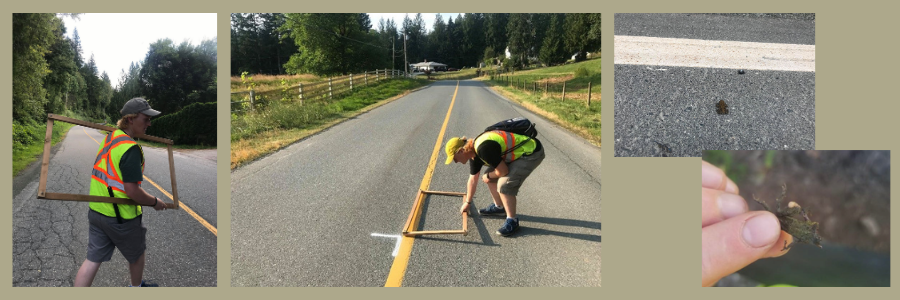This year’s toadlet motto was “better late than never”!
Check out this first-hand account written by Molly Tilden.
On July 20th, developing toadlets were seen congregating on lily pads and along the shoreline. We were happy to see that, unlike last year, they were staging in the usual area with direct access to our toad fence.

Over the next 10 days, the toadlets made slow progress through the hayfield. They were seen clumped throughout the grass as they meandered towards the road. We were just beginning to wonder if they would ever leave the hay field. They finally made it to the fencing on July 29th!

This year was especially exciting for us summer students because we were able to witness the toads using our brand-new Animex permanent fence that we spent much of the summer installing.

It was simply amazing to see our hard work paying off as we watched the toadlets hopping along the fence, unable to climb its slippery surface, and funneling into the toad tunnel. We didn’t see any toadlets breach the new fence. It was officially toad-proof!
As summer students, we were responsible for conducting morning and evening surveys along a six-kilometer route including Elk View, Huston, and Ryder Lake Roads. We counted all the dead and live toads found on the road along our route. We also used a wooden sampling frame every 50m to count dead and live toadlets in 59 predetermined plots. This data is important so we can compare mortality numbers with previous years to better understand how well the tunnel and fencing is working to save toad lives.

So is it working?
This graph shows the combined data from road surveys starting in 2014, prior to the tunnel installation, and all subsequent years post-installation, including this year’s migration. As you can see, the black graph for this year shows toadlets were only found on Elk View Road, and at the intersection with Ryder Lake Road. No toadlets were seen on Huston Road this year. The area of the road protected by the fencing and tunnel is indicated by the red bar along the bottom. The yellow graph from pre-tunnel installation shows how this was area was a toadlet crossing hot spot. And again this year the data shows that the number of toads on the road in the graph has been effectively flattened!

The 2020 toadlet migration was relatively small compared to previous years. In total 10,500 toadlets were counted in the tunnel. As a reference, in 2018 the toadlets migrated in a very similar pattern, and over 73,000 toadlets were counted in the tunnel. Many Ryder Lake locals expressed their surprise at the low numbers of toads on the road, but there are many possible explanations for this:
- Surveys conducted in the spring of this year indicated fewer adult toads traveling to the wetland to breed, compared to previous years, which may have led to fewer egg masses and resultant toadlets.
- Toads reach reproductive maturity at around 4-5 years of age, so low numbers of toadlets this year could reflect a low reproductive year 4-5 years ago. In spring 2016, the lowest number of migrating adult toads were observed, which may be an indicator of this cycle in action.
- American Bullfrogs recently invaded the breeding pond and may be consuming toad tadpoles and toadlets, reducing overall numbers. See this link for information about how the FVC is working to tackle the bullfrogs: https://fraservalleyconservancy.ca/bullfrog/.
With COVID-19 keeping people closer to home this summer, many of us have turned to local trails to seek fun and relaxation amidst the pandemic. While more people connecting with nature is great, it does pose a greater threat to the toadlets due to the increased traffic along Elk View Road from hikers. For this reason, we asked the community to use our voluntary detour route, avoiding the section of Elk View Road closest to the wetland, and to limit toad viewing to our online posts.
We want to offer a huge THANK YOU to everyone in the community who followed these guidelines and helped protect the toads. During our surveys, we saw you taking the detour and can attest that the toadlets appreciated your consideration.

This project would not be possible without the generous support from our wonderful donors and volunteers along with:
